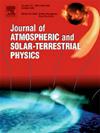Characteristics of decametric hectometric (DH) type IIs, CMEs and flares of geoeffective and non-geoeffective storm events in Solar Cycle 24
IF 1.8
4区 地球科学
Q3 GEOCHEMISTRY & GEOPHYSICS
Journal of Atmospheric and Solar-Terrestrial Physics
Pub Date : 2025-01-29
DOI:10.1016/j.jastp.2025.106440
引用次数: 0
Abstract
In this paper, a statistical study on geoeffectiveness of CMEs integrated with decametric hectometric (DH) type-II radio bursts, association of Dst with plasma and interplanetary field parameters (T,V,P, , Bz,Bt,E) and their product function BzV for solar cycle 24 is presented. We have selected 119 DH-CME events from March 2008 to December 2015. Based on minimum Dst index nT of geomagnetic storm, the events are assorted into two groups, specifically (i) Geoeffective events (ii) Non-geoeffective events. The geoeffective events are found to have high start frequency, low end frequency, broad bandwidth, long duration, slower drift rate than non-geoeffective events. CME speed and flare flux for geoeffective events are moderately correlated(r=0.50) which shows that flares may be related to geomagnetic storms through CMEs. Higher speed of CMEs associated with geoeffective events suggests that CME speed is an important parameter for geoeffectiveness. A large fraction of CME associated with DH-type-II radio bursts are linked with geomagnetic storm which again indicates that CMEs accompanied by DH-type-II radio bursts are effectively responsible for producing geomagnetic storms. A good correlation of Dst with BzV(r) reflects that interplanetary field and plasma parameters also play an important role in the occurrence of geomagnetic storms.

求助全文
约1分钟内获得全文
求助全文
来源期刊

Journal of Atmospheric and Solar-Terrestrial Physics
地学-地球化学与地球物理
CiteScore
4.10
自引率
5.30%
发文量
95
审稿时长
6 months
期刊介绍:
The Journal of Atmospheric and Solar-Terrestrial Physics (JASTP) is an international journal concerned with the inter-disciplinary science of the Earth''s atmospheric and space environment, especially the highly varied and highly variable physical phenomena that occur in this natural laboratory and the processes that couple them.
The journal covers the physical processes operating in the troposphere, stratosphere, mesosphere, thermosphere, ionosphere, magnetosphere, the Sun, interplanetary medium, and heliosphere. Phenomena occurring in other "spheres", solar influences on climate, and supporting laboratory measurements are also considered. The journal deals especially with the coupling between the different regions.
Solar flares, coronal mass ejections, and other energetic events on the Sun create interesting and important perturbations in the near-Earth space environment. The physics of such "space weather" is central to the Journal of Atmospheric and Solar-Terrestrial Physics and the journal welcomes papers that lead in the direction of a predictive understanding of the coupled system. Regarding the upper atmosphere, the subjects of aeronomy, geomagnetism and geoelectricity, auroral phenomena, radio wave propagation, and plasma instabilities, are examples within the broad field of solar-terrestrial physics which emphasise the energy exchange between the solar wind, the magnetospheric and ionospheric plasmas, and the neutral gas. In the lower atmosphere, topics covered range from mesoscale to global scale dynamics, to atmospheric electricity, lightning and its effects, and to anthropogenic changes.
 求助内容:
求助内容: 应助结果提醒方式:
应助结果提醒方式:


